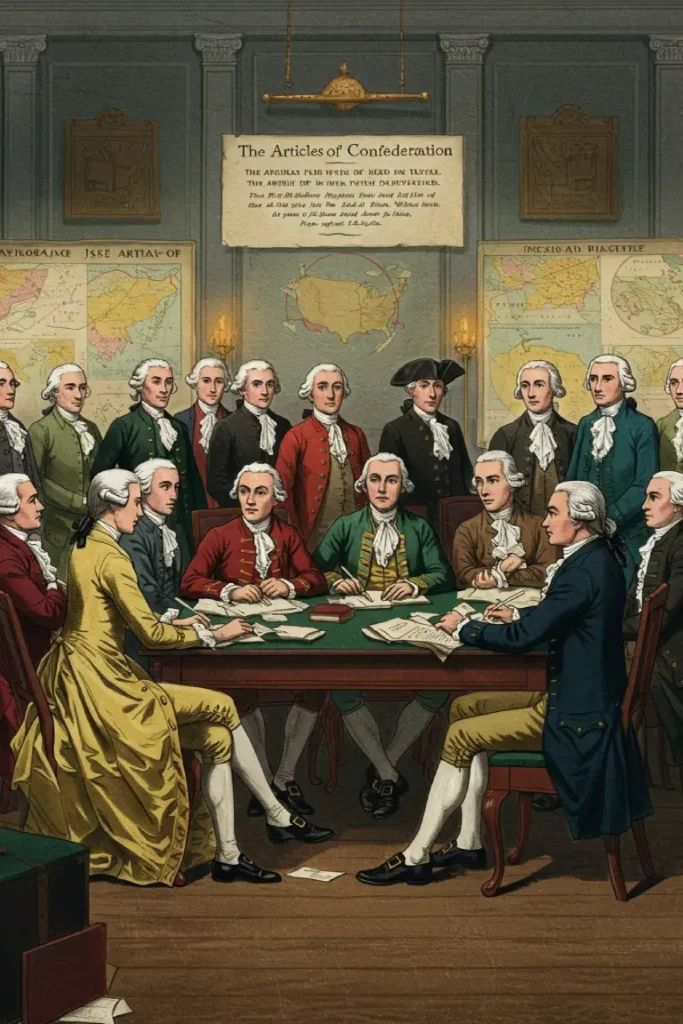The Articles of Confederation represent a pivotal yet often overlooked chapter in American history. Drafted during the Revolutionary War and ratified in 1781, this document served as the fledgling United States’ first constitution. It was a bold experiment in governance, an attempt to unify thirteen independent colonies under a single framework while preserving their autonomy. However, while the Articles provided a foundation for collaboration, they also revealed significant weaknesses that ultimately led to their replacement by the U.S. Constitution in 1789.
In this article, we will explore the origins, structure, achievements, and shortcomings of the Articles of Confederation, as well as their lasting impact on American governance.
The Origins of the Articles of Confederation
The need for a unifying document arose during the Revolutionary War, as the thirteen colonies sought to coordinate their efforts against British rule. The Continental Congress recognized that a formal agreement was necessary to establish legitimacy and facilitate cooperation among the colonies. In 1776, a committee led by John Dickinson drafted the Articles of Confederation, which were debated and revised over several years before all thirteen states finally ratified them in 1781.
The Articles were designed to balance the need for unity with the colonies’ deep-seated fears of centralized authority. Having fought a war against what they perceived as British tyranny, the states were wary of creating a powerful national government that might infringe upon their rights.
The Structure of Government Under the Articles
The Articles of Confederation established a confederation—a loose alliance of sovereign states. The national government consisted of a single legislative body known as the Congress of the Confederation. Each state had one vote in Congress, regardless of its size or population. There was no separate executive branch or national judiciary, leaving Congress as the sole governing authority.
Key features of the government under the Articles included:
- State Sovereignty: The states retained most powers, including the authority to regulate commerce and levy taxes.
- Limited National Powers: Congress could declare war, negotiate treaties, manage foreign relations, and handle disputes between states. However, it lacked the power to enforce its decisions or collect taxes directly.
- Unanimous Consent for Amendments: Any changes to the Articles required unanimous approval from all thirteen states, making reforms nearly impossible.
This decentralized structure reflected the colonies’ desire to protect their independence but also created significant challenges for effective governance.
Achievements Under the Articles of Confederation
Despite its limitations, the Articles of Confederation were not without accomplishments. They provided a framework for collective action during a critical period in American history. Some notable achievements include:
- Winning the Revolutionary War: The Articles helped coordinate military efforts and secure international support, including crucial alliances with France.
- The Treaty of Paris (1783): Under the Articles, Congress negotiated and signed this treaty, which formally ended the Revolutionary War and recognized American independence.
- The Northwest Ordinance (1787): One of the most significant legislative acts under the Articles, this ordinance established a process for admitting new states to the Union and prohibited slavery in the Northwest Territory.
These successes demonstrated the potential for collaboration among the states but also underscored the need for a stronger central government.

The Weaknesses of the Articles of Confederation
While the Articles provided a starting point for national unity, their flaws became increasingly apparent over time. Key weaknesses included:
- Lack of Central Authority: Without an executive branch or national judiciary, Congress had no means to enforce laws or resolve disputes effectively.
- Inability to Tax: Congress relied on voluntary contributions from the states to fund its operations, leading to chronic financial instability and an inability to pay debts or support a standing army.
- Interstate Conflicts: States often pursued their own interests at the expense of national unity, imposing tariffs on each other and competing over trade.
- Amendment Process: The requirement for unanimous consent made it nearly impossible to address these issues through amendments.
These shortcomings became particularly evident during events like Shays’ Rebellion (1786–1787), an uprising by farmers in Massachusetts protesting economic hardship and high taxes. The federal government’s inability to respond effectively highlighted the need for reform.
The Transition to the U.S. Constitution
By 1787, it was clear that the Articles of Confederation were insufficient for governing a growing and diverse nation. Delegates from twelve states convened at the Constitutional Convention in Philadelphia to address these issues. Rather than amending the Articles, they drafted an entirely new constitution that created a stronger federal government with separate executive, legislative, and judicial branches.
The U.S. Constitution was ratified in 1789, replacing the Articles of Confederation and establishing a more balanced system of governance. While the Constitution addressed many of the weaknesses of the Articles, it also built upon their foundation by incorporating lessons learned from America’s first attempt at unity.
FAQs About the Articles of Confederation
1. What were the main goals of the Articles of Confederation?
The primary goals were to unify the thirteen colonies during the Revolutionary War, establish legitimacy as an independent nation, and create a framework for cooperation while preserving state sovereignty.
2. Why did the Articles of Confederation fail?
The Articles failed due to their inability to create a strong central government capable of enforcing laws, collecting taxes, resolving disputes, and addressing economic challenges.
3. What is the significance of the Northwest Ordinance?
The Northwest Ordinance was a major achievement under the Articles. It established a process for admitting new states to the Union and set important precedents for territorial governance and banning slavery in new territories.
4. How did Shays’ Rebellion highlight the weaknesses of the Articles?
Shays’ Rebellion exposed the federal government’s inability to maintain order or provide economic relief due to its lack of resources and authority under the Articles.
5. What lessons did America learn from the Articles of Confederation?
The experience with the Articles highlighted the need for a balance between state and federal powers, as well as a more robust central government capable of addressing national challenges.
Conclusion
The Articles of Confederation marked America’s first attempt at unity and self-governance. While flawed, they played a crucial role in guiding the young nation through its formative years and laid the groundwork for future constitutional development. By understanding both their successes and failures, we gain valuable insights into the evolution of American democracy and the enduring challenge of balancing state and federal powers.





